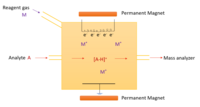Chemical ionization

Hey there! Have you ever seen a balloon being filled with air or helium gas? Chemical ionization is just like that! It's a process where we fill a gas (usually a noble gas like helium) with tiny chemical particles called ions.
Imagine that you're playing with building blocks and you have a big pile of different colored blocks. If you want to make a tower or a castle, you need to find the right blocks and stack them up. But sometimes it's hard to find the right blocks because they all look the same!
That's where chemical ionization comes in. It's like coloring some of the blocks with a special paint, so you can easily spot them.
In chemical ionization, we take a gas (like helium) and add some special chemicals to it. These chemicals are called reagents, and they are like the special paint for the building blocks. When we add the reagents to the gas, they start reacting with each other and create tiny particles called ions.
These ions are different from normal atoms or molecules because they have an electric charge. Just like magnets, some ions are positively charged and others are negatively charged. These charged particles can easily stick to other molecules in the air, like water vapor or carbon dioxide.
So, imagine that you're playing with blocks again, but this time you have a special magnet that can pick up only the colored blocks. When you turn on the magnet, it attracts all the colored blocks and leaves the other ones behind. That's how chemical ionization works - the ions act like the magnet, attracting certain molecules while repelling others.
Scientists use chemical ionization to study different types of molecules in the air or in a sample. By adding specific reagents, they can create ions that are attracted to certain molecules, allowing them to measure the amount of those molecules present.
So there you have it - chemical ionization is like coloring some of the building blocks so you can easily find them, and using a magnet to pick them up!
Imagine that you're playing with building blocks and you have a big pile of different colored blocks. If you want to make a tower or a castle, you need to find the right blocks and stack them up. But sometimes it's hard to find the right blocks because they all look the same!
That's where chemical ionization comes in. It's like coloring some of the blocks with a special paint, so you can easily spot them.
In chemical ionization, we take a gas (like helium) and add some special chemicals to it. These chemicals are called reagents, and they are like the special paint for the building blocks. When we add the reagents to the gas, they start reacting with each other and create tiny particles called ions.
These ions are different from normal atoms or molecules because they have an electric charge. Just like magnets, some ions are positively charged and others are negatively charged. These charged particles can easily stick to other molecules in the air, like water vapor or carbon dioxide.
So, imagine that you're playing with blocks again, but this time you have a special magnet that can pick up only the colored blocks. When you turn on the magnet, it attracts all the colored blocks and leaves the other ones behind. That's how chemical ionization works - the ions act like the magnet, attracting certain molecules while repelling others.
Scientists use chemical ionization to study different types of molecules in the air or in a sample. By adding specific reagents, they can create ions that are attracted to certain molecules, allowing them to measure the amount of those molecules present.
So there you have it - chemical ionization is like coloring some of the building blocks so you can easily find them, and using a magnet to pick them up!
Related topics others have asked about:
